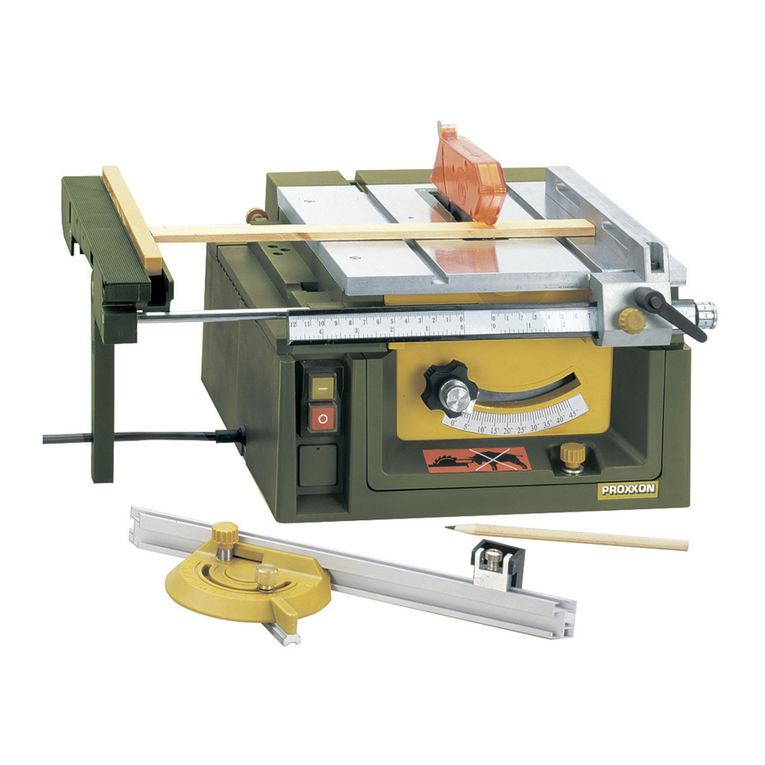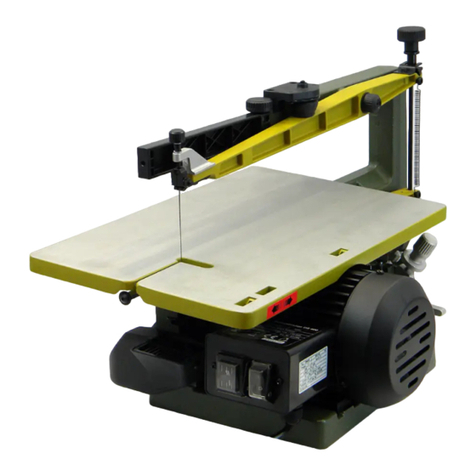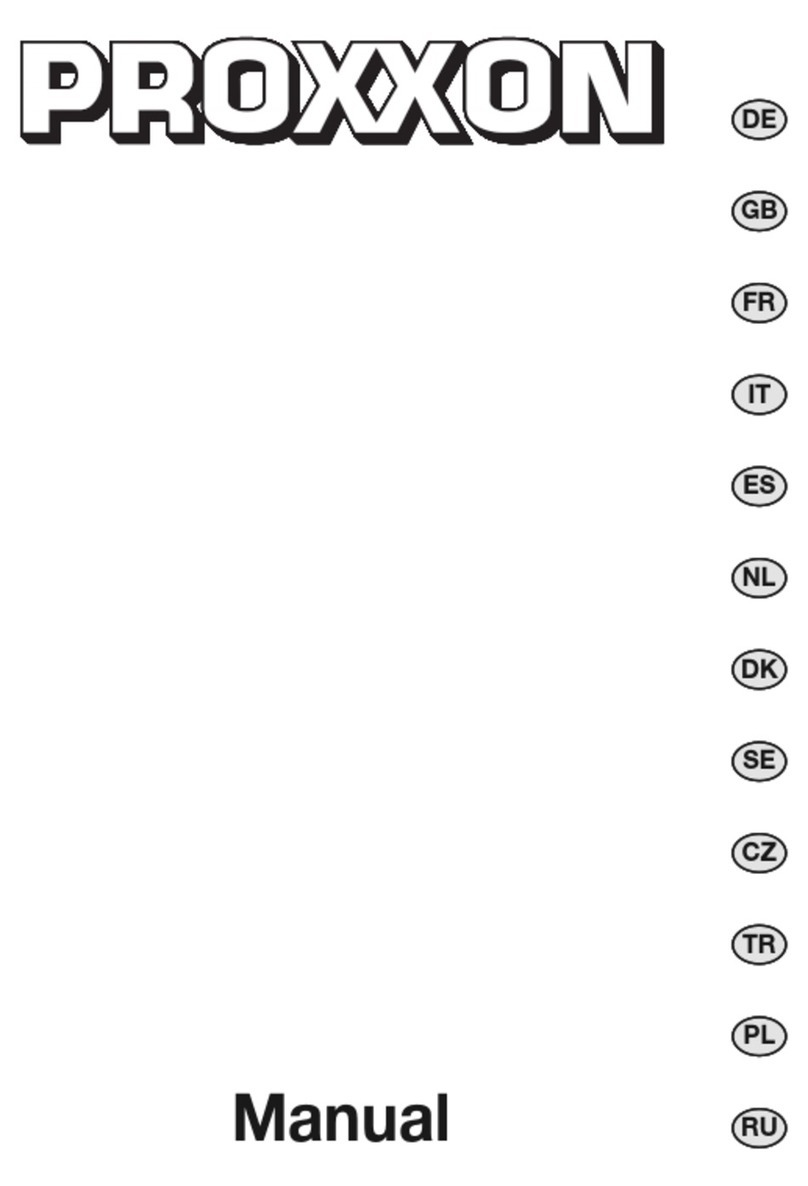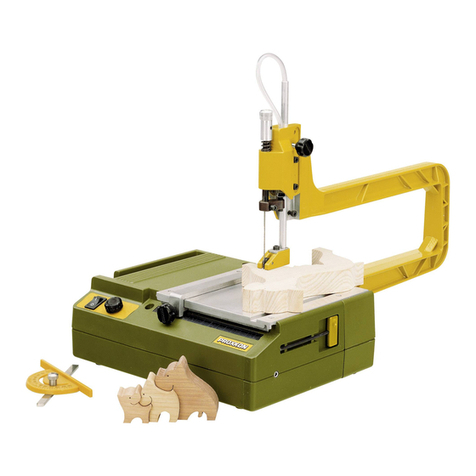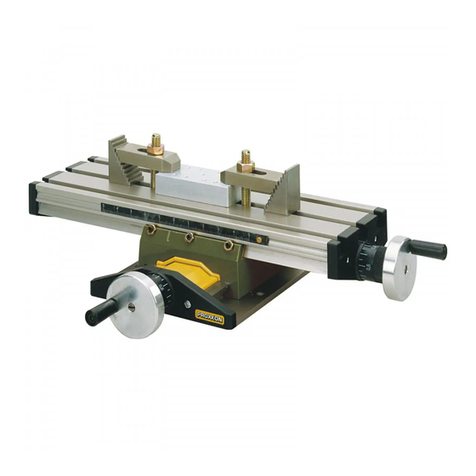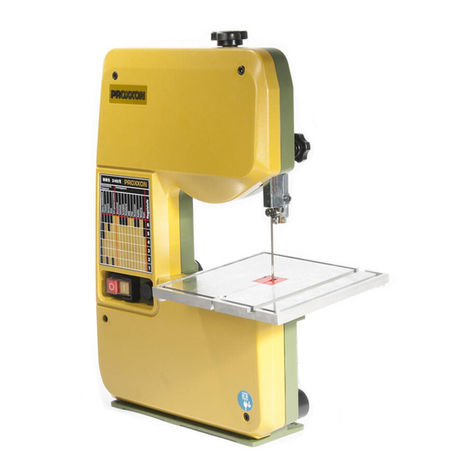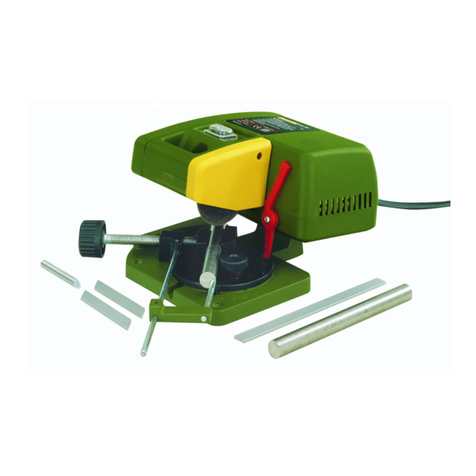
Dear Customer,
By purchasing your PROXXON MICRO Band Saw
MBS/E, you havechosen agood-quality,high-grade
machine.
In order to operate the MICRO Band Saw safely and
correctly,please read the enclosed safety information
and operating instructions prior to operation.
1. General safety instructions………………………5
2.Additional safety regulations……………………6
3.Additional safety instructions for band saws …6
4. Grounding Instructions…………………………7
5. Description of machine …………………………7
5.1. Legend (Fig. 1) ……………………………………7
5.2.Introduction ………………………………………7
5.3.Specifications……………………………………8
5.4. Scope of supply…………………………………8
6.Machine set-up……………………………………8
6.1. Attaching the work table to the saw……………8
6.2.Checking and verticaladjusting of the upper
blade guide assembly……………………………8
6.2.1. Verticaladjusting of the upper blade guide……8
6.2.2.Checking and adjusting the blade width………8
6.2.3.Using a vacuumcleaner…………………………8
6.2.4. Adjusting tension of the saw blade ……………9
7.Operating the MICRO Band Saw………………9
7.1. Starting operation…………………………………9
7.1.1. Lockable Switch…………………………………9
7.2.Adjusting blade speed……………………………9
7.3.Sawing ……………………………………………9
7.3.1. Free-hand sawing…………………………………9
7.3.2.Sawing with miter guide …………………………9
7.3.3.Operation with the diamond saw blade………10
8. Careand Maintenance…………………………10
8.1. Checking and adjusting lower blade guide …10
8.2.Changing the saw blade ………………………10
8.3.Changing the rubber rings on the wheels……11
8.4. Careand cleaning of the machine ……………11
9. OptionalAccessories……………………………11
10.Accessory Blades………………………………11
This instruction manualcovers:
• safety regulations
•operation and maintenance
• spare parts list
Please readcarefully!
Using this instruction manual will
•make it easier for youto get used to the machine,
•help preventfaults occurring due to improper useand
•increasethe service life of your machine.
Keep this instruction manualinan easily accessible
place. Only operate this machine if you are qualified to
do soand follow the guidelines in this instruction
manual.
Readand become familiar with this entire instruction
manual,learn the tool`s applications,limitations and
possible hazards.
PROXXON does not accept responsibility for the safe
functioning of the machine,
•if it is handled in amanner whichconstitutes
improper use;
•if it is used for other purposes it is not intended and
designed for;
•if it is used for other purposes whichare not speci-
fied in the instruction manual;
•if the safety regulations are not observed.
•Warranty claims are invalid,if the machine is incor-
rectly operated,or the machine has not been suffi-
ciently maintained.
In the interests of your safety,pleasealways observe
the safety regulations.Failure to follow the instructions
listed below,may result in electric shock,fire, and/or
serious personal injury or property damage. This can
result in serious injury or possibly even death.
Only use genuine PROXXON spare parts.
We reserve the right to make further alterations for the
purpose of technical progress.
We wish you every success with your machine.
Readand understand the entire owners manual
beforeattempting assembly or operation!
1. General safety instructions
1. KEEP GUARDS IN PLACE and in working order.
2.REMOVE ADJUSTING KEYS AND WRENCHES.
Form habit of checking to see that keys and
adjusting wrenches are removed from tool before
turning it on.
3.KEEP WORK AREA CLEAN.Cluttered areas and
benches inviteaccidents.
4. DON'T USE IN DANGEROUS ENVIRONMENT.
Don't use power tools in damp or wet locations,or
expose them to rain. Keep workarea well lighted.
5. KEEP CHILDREN AWAY.All visitors should be kept
safe distance from workarea.
6.MAKE WORKSHOP KID PROOF with padlocks,
master switches,or by removing starter keys.
7.DON'T FORCE TOOL.It will do the job better and
safer at the rate for which it was designed.
8. USE RIGHT TOOL.Don't force tool or attachment
todoajobfor which it was not designed.
9. USE PROPER EXTENSION CORD.Make sure your
extension cord is in good condition. When using an
extension cord, be sure to use one heavy enough
tocarry the current your product will draw.An
undersized cord will causeadrop in line voltage
resulting in loss of power and overheating. Table 1
shows the correct size to use depending on cord
lengthand nameplateampere rating. If in doubt,
use the next heavier gage. The smaller the gage
number, the heavier the cord.
Exception No. 1: The reference to the table and the
table itself may be omitted if a statement indicating
the appropriate gage and length is incorporated
into the instruction.
Exception No. 2: The information regarding exten-
sion cords need not be provided for apermanently
connected tool.
10.WEAR PROPER APPAREL.Do not wear loose
clothing,gloves,neckties, rings, bracelets,or other
-5-
